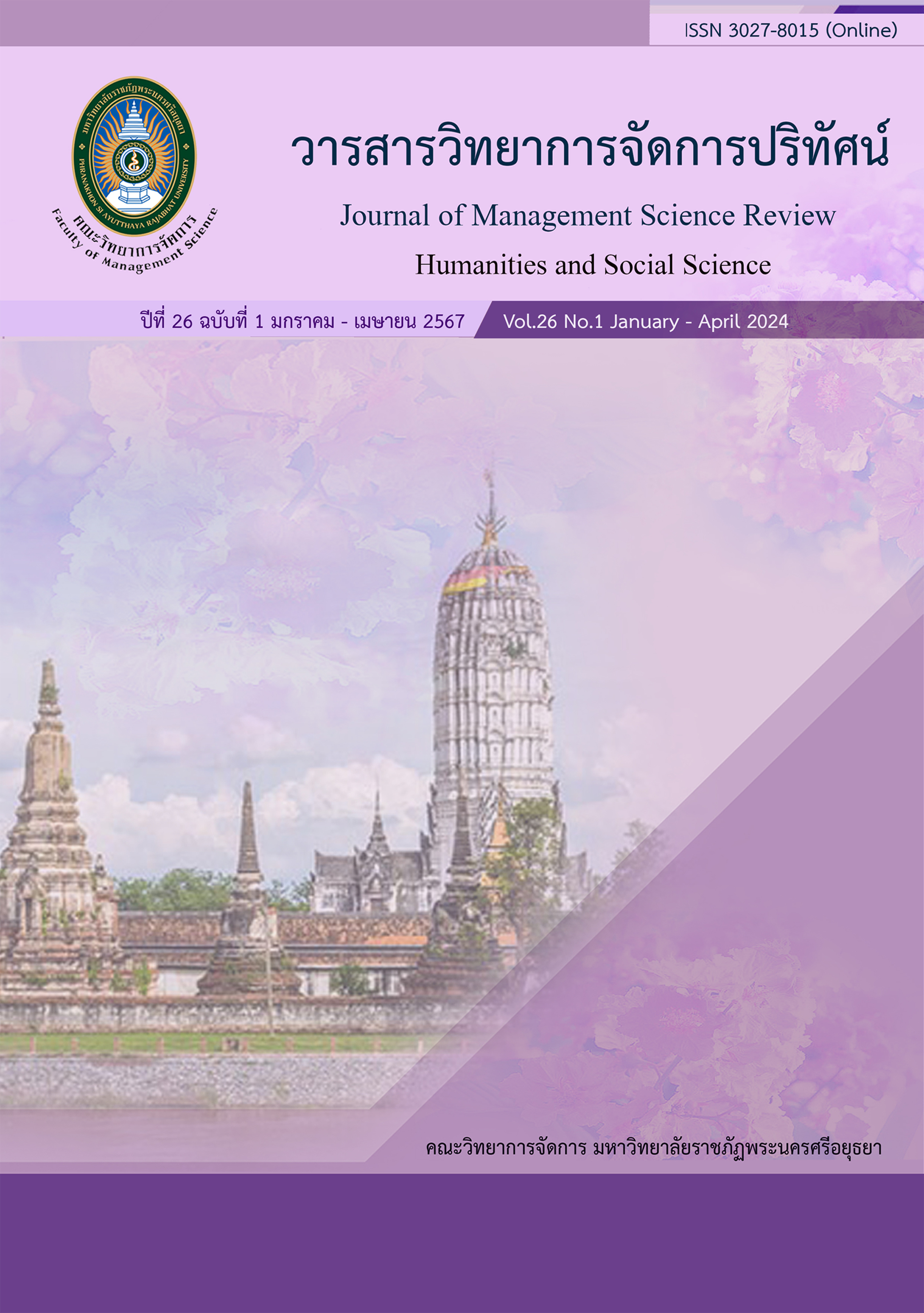อิทธิพลของไคเซ็นความปลอดภัยและการตระหนักความปลอดภัยที่ส่งผลต่อพฤติกรรมความปลอดภัยในการทำงานของพนักงานในโรงงานอุตสาหกรรมอลูมิเนียมแห่งหนึ่ง
คำสำคัญ:
ไคเซ็นความปลอดภัย, วัฒนธรรมปลอดภัย, การตระหนักความปลอดภัย, พฤติกรรมความปลอดภัยในการทำงานบทคัดย่อ
การศึกษาครั้งนี้มีวัตถุประสงค์เพื่อ 1) ศึกษาระดับความคิดเห็นของพนักงานในโรงงานอุตสาหกรรมอลูมิเนียมแห่งหนึ่งที่มีต่อไคเซ็นความปลอดภัย วัฒนธรรมความปลอดภัย การตระหนักความปลอดภัย และพฤติกรรมความปลอดภัยของพนักงาน และ 2) ศึกษาอิทธิพลของไคเซ็นความปลอดภัยและการตระหนักความปลอดภัยที่ส่งผลต่อพฤติกรรมความปลอดภัยในการทำงานของพนักงานในโรงงานอุตสาหกรรมอลูมิเนียมแห่งหนึ่ง โดยใช้แบบสอบถามในการเก็บข้อมูลกับกลุ่มตัวอย่างพนักงานส่วนสำนักงาน ส่วนโรงงาน และส่วนสโตร์จัดส่งที่มีอายุตั้งแต่ 18 ปีขึ้นไป ในโรงงานอุตสาหกรรมอลูมิเนียมแห่งหนึ่ง จำนวน 500 คน ใช้การวิเคราะห์ข้อมูลด้วยค่าร้อยละ ค่าเฉลี่ย ส่วนเบี่ยงเบนมาตรฐาน และการทดสอบสมมติฐานด้วยการวิเคราะห์ตัวแบบสมการโครงสร้าง Smart PLS 4.0 ผลการศึกษาพบว่า 1) ไคเซ็นความปลอดภัย มีค่าเฉลี่ยเท่ากับ 4.33 การตระหนักความปลอดภัย มีค่าเฉลี่ยเท่ากับ 4.45 และวัฒนธรรมความปลอดภัย ด้านการรับรู้ มีค่าเฉลี่ยเท่ากับ 4.30 ด้านพฤติกรรม มีค่าเฉลี่ยเท่ากับ 4.27 และด้านจิตวิทยาภายในองค์กร มีค่าเฉลี่ยเท่ากับ 4.31 มีผลต่อพฤติกรรมความปลอดภัยในการทำงาน 2) ตัวแปรปัจจัยด้านไคเซ็นความปลอดภัยมีอิทธิพลเชิงบวกต่อปัจจัยด้านวัฒนธรรมความปลอดภัย ตัวแปรปัจจัยด้านความตระหนักเรื่องความปลอดภัยมีอิทธิพลเชิงบวกต่อปัจจัยด้านวัฒนธรรมความปลอดภัย ตัวแปรปัจจัยด้านวัฒนธรรมความปลอดภัยมีอิทธิพลเชิงบวกต่อพฤติกรรมความปลอดภัยในการทำงาน ตัวแปรปัจจัยด้านความตระหนักเรื่องความปลอดภัยมีอิทธิพลเชิงบวกต่อพฤติกรรมความปลอดภัยใน การทำงาน อย่างมีนัยสำคัญที่ระดับ .05 ส่วนปัจจัยด้านไคเซ็นความปลอดภัยไม่มีอิทธิพลเชิงบวกต่อพฤติกรรมความปลอดภัยในการทำงานอย่างมีนัยสำคัญ
เอกสารอ้างอิง
Beatrice, O. O. (2011). Influencing safety culture in the UK Offshore Oil and Gas Industry: The importance of employee involvement. [Master's thesis]. Robert Gordon University.
Buddharaja, K. S. (2009). Factors affecting work improvement behavior of production employees using the Kaizen system, Case study of Namkarnchang factory. [Master's thesis]. Chandrakasem Rajabhat University.
Chaichotkit, A. (2011). Perception of safety culture of Thai workers in a consumerist way of life. Journal of Social Sciences and Humanities, 37(2), 199-211.
Chin, W. W. (1998). The Partial Least Squares Approach to Structural Equation Modeling. New Jersey: Lawrence Erlbaum Associates.
Choudhry, R.M., Fang, D., & Mohamed, S. (2007). Developing a Model of Construction Safety Culture. Journal of Management in Engineering, 23, 207-211.
Comrey, A. L., & Lee, H. B. (1992). A First Course in Factor Analysis (2nd ed.). New Jersey: Lawrence Erlbaum.
Cronbach, L. J. (1974). Essentials of Psychological Testing (3 rd ed.). New York: Harper and Row.
Dale, E. (1969). Audio-Visual Methods in Teaching (3rd ed.). New York: Dryden.
Disthakul, Si. (2016). Ministerial regulations specifying standards for administration, management, and operations regarding safety, occupational health, and the environment. Retrieved from http://cste.sut.ac.th/csteshe/wp-content/lews/ Law06.pdf.
Frazier, C. B. (2011). A Hierarchical factor analysis of a safety culture survey. Appalachian State University.
Khruekanchana, S. (2009). Increase work efficiency with Kaizen (6 th ed.). Bangkok: Thai-Japan Technology Promotion Association.
Luengsaadkul, C. (2013). Effectiveness of the program to create a safety culture for volunteer rescuers in pollution control areas. Rayong Province National Institute of Emergency Medicine, Map Ta Phut Hospital
La-ongsawong, W. (1998). Factors influencing the perception of dangerous working conditions and safe working behavior of employees operating in the steel production industry. [Master’s thesis]. Kasetsart University.
Meepradit, Y. (2015). Development of a proactive safety culture model in the manufacturing industry system of Thailand. [Doctoral dissertation]. Silpakorn University.
Muangsarot, R. (2010). Factors influencing safety culture in the petrochemical industry. [Doctoral dissertation]. National Institute of Development Administration.
Muangphra, S. (1994). A study of the health behavior of workers at the operational level on Preventing work-related accidents: Studying only the case of the metal product manufacturing industry. Machinery and equipment Bang Pakong District Chachoengsao Province. [Master’s thesis]. Thammasat University.
Pisitsak, J. (2018). Relationship between safety culture factors and work safety behavior of construction industry workers. Rajanagarindra Rajabhat University.
Rovinelli, R. J., & Hambleton, R. K. (1977). On the Use Content Specialist in the Assessment of Criterin Reference Test Item Validity. Dutch Journal of Educational Research,
Sarstedt, Ringle, & Hair. (2017). Partial Least Squares Structural Equation Modeling. Illinois: Irwin.
Schein, E. H. (1991). Organizational culture and leadership. San Francisco, Calif.: Jossey Bass.
Schumacker, R. E., & Lomax, R. G. (2016). A Beginner's Guide to Structural Equation Modeling (4 th ed.). New York: Routledge/Taylor & Francis Group.
Sermphongphan, T. (2011). Maintenance engineering. Bangkok: King Mongkut's Institute of Technology North Bangkok.
Simachokdee, W., & Chalermjirarat, W. (2004). Engineering and safety management in factories (17th ed.). Bangkok: Thai-Japan Technology Promotion Association.
Sinamnuayphon, P. (2014). Increasing work efficiency with the Kaizen concept. Retrieved February, 1, 2024, from https://www.stou.ac.th/study/sumrit/5-58 (500)/page5-5-58(500).html.
Srimarut, T. et al. (2012). Factors affecting work safety behavior of employees at production operations level, Siam Metal Technology Company Limited, Rayong Province. [Master's thesis]. Suan Sunandha Rajabhat University.
Sud-arom, P., & Nuritmon, W. (2018). Awareness of work safety affects work safety behavior of operational employees in Polyfoam Company Limited. Valaya Alongkorn Review Journal (Humanities and Social Sciences), 8(3), 114 – 125.





